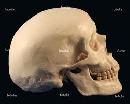Astronomy
Biology
Chemistry
Documentaries
Earth Sciences
Humanity
Life On Earth
Mathematics
Physics
Science Fiction
Technology
Biology
Chemistry
Documentaries
Earth Sciences
Humanity
Life On Earth
Mathematics
Physics
Science Fiction
Technology

The Berkeley Department of Integrative Biology offers a program of instruction that focuses on the integration of structure and function in the evolution of diverse biological systems. It investigates integration at all levels of organization from molecules to the biosphere, and in all taxa of organisms from viruses to higher plants and animals. Course given by Professor Marian Diamond, filmed Fall 2005.
Posted in Berkeley
Professor Diamond begins this biology lecture with a piece on the human brain (using a preserved specimen), then launches into a discussion into the basics of the muscular system. Includes - functional types, muscle origins and insertions.
Posted in Berkeley
This lecture provides an overview of the Human skeletal system, addressing such things as connective tissues, identifying regions of the body, histology, and how to spot the characteristics of bones.
Posted in Berkeley
This Berkeley lecture starts with an overview of cells involved in the skeletal system, from the overall structure of various cells to their shape, function, and identification. Then goes into the structure of the skull.
Posted in Berkeley
This biology lecture begins with an overview of the Human skull before discussing its connection to the spinal column. Professor Diamond then describes the vertebral column, from the structure of the vertebrae to the thoracic cavity.
Posted in Berkeley
This lecture gives a strong overview of the appendicular skeleton. The word appendicular is the adjective of the noun appendage, and this lectures covers the structure of the arms and some of the legs.
Posted in Berkeley
This lecture discusses the functionality and structure of the lower leg, from synovial joints to the tibia. Also addresses common ailments of the leg, including arthritic inflammation.
Posted in Berkeley
This lecture continues on the discussion of afflictions to the skeletal system including osteoporosis. Professor Diamond continues on to further address the types of cartilage and the formation of bone.
Posted in Berkeley
You've learned about the skeleton, now it is time to introduce the muscular system and its relation to the skeletal system. This lecture provides an overview of the muscles in the head from the occipitofrontalis muscle to the orbicularis oculi.
Posted in Berkeley
Professor Diamond begins by discussing the trapezius, its origin and insertion, and how this relates to its function as an adductor. The lecture then explains the origin and insertion of the latissimus dorsi, pectoralis major, and deltoid muscles.
Posted in Berkeley
Professor Diamond begins this lesson with the muscular structure of the abdomen, including the rectus abdominis and external oblique muscle. She ends the lecture with the muscles of the hip, including the gluteal muscle.
Posted in Berkeley
This lecture continues describing the Human muscular system, beginning with the gluteal muscles and muscles of the thigh and leg. Among the topics discussed is muscle histology and the femoral triangle.
Posted in Berkeley
Hematology is the branch of medicine that deals with blood, the blood-forming organs, and blood diseases. This discusses topics including plasma, multiple sclerosis, and erythropoiesis (the process by which red blood cells are formed).
Posted in Berkeley
This blood themed lecture covers the structure and function of several immune related systems. Among the topics discussed you will learn about leukocytes, t-cells, and basophil granulocytes. |
Copyright 2006-2014 Educated Earth











